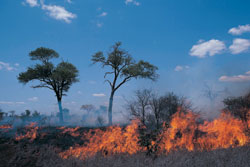Forests
Forests provide homes for many kinds of plants and animals. They also protect water quality, offer opportunities for recreation, and provide people with wood. Forests are sensitive to many effects of climate change, including shifting weather patterns, drought, wildfires, and the spread of pests like the mountain pine beetle. Unlike some animals, trees can't just get up and move when the temperature gets too hot or other conditions change!
What's at stake?
Wildfires
 Wildfires are already common in the forests and grasslands of the western United States. As the Earth gets warmer and droughts increase, wildfires are expected to occur more often and be more destructive. Wildfires do occur naturally, but the extremely dry conditions resulting from droughts allow fires to start more easily, spread faster, and burn longer. In fact, if the Earth gets just 3.6°F warmer, we can expect wildfires in the western United States to burn four times more land than they do now. Fires don't just change the landscape; they also threaten people's homes and lives.
Wildfires are already common in the forests and grasslands of the western United States. As the Earth gets warmer and droughts increase, wildfires are expected to occur more often and be more destructive. Wildfires do occur naturally, but the extremely dry conditions resulting from droughts allow fires to start more easily, spread faster, and burn longer. In fact, if the Earth gets just 3.6°F warmer, we can expect wildfires in the western United States to burn four times more land than they do now. Fires don't just change the landscape; they also threaten people's homes and lives.
- What can people do about it?
As the climate continues to change, people will have to prepare for the risk of increasing wildfires by becoming more aware of the danger, taking extra precautions to prevent fires, not building in fire-prone areas, and being ready to manage fires when they do occur.
Learn more
- Find out more about how people can prepare for the increased risk of wildfires.